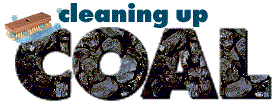John Galt Faces Prison For Contaminating West Virginia Water
Back in January, John Galt proclaimed his independence from pesky regulatory oversight in West Virginia when he contaminated the drinking water supply of over 300,000 residents. Recall that Galt did his damage through his appropriately named corporation, Freedom Industries, where he was using the contaminant to magically make coal “clean”. In a remarkable development, though, we learned yesterday that a federal grand jury has indicted six people associated with Freedom Industries:
A federal grand jury on Wednesday indicted four owners and operators of the company whose toxic chemical spill tainted a West Virginia river in January, forcing a prolonged cutoff of drinking water to nearly 300,000 residents in and around Charleston.
Each was charged with three counts of violating the Clean Water Act, which bars discharges of pollutants without a permit. Their company, Freedom Industries, and its owners and managers did not meet a reasonable standard of care to prevent spills, the indictment stated.
One of those indicted, Gary L. Southern, the company’s president, was also charged with wire fraud, making false statements under oath and bankruptcy fraud. Freedom declared bankruptcy days after the spill.
Actual prison time is at stake in these charges:
Besides Mr. Southern, of Marco Island, Fla., the indictment named three other owners and operators: Dennis P. Farrell, 58, of Charleston; William E. Tis, 56, of Verona, Pa.; and Charles E. Herzing, 63, of McMurray, Pa.
Two others were also charged: Robert J. Reynolds, 63, of Apex, N.C., and Michael E. Burdette, 63, of Dunbar, W.Va. Mr. Reynolds was Freedom’s environmental consultant, and Mr. Burdette managed the tank farm. Mr. Herzing, Mr. Tis and Mr. Farrell sold the tank farm to a Pennsylvania company about a month before the accident.
All six were charged with the negligent discharge of a pollutant, negligent discharge of a refuse matter and violating an environmental permit. The violations carry a maximum penalty of three years in prison, according to a statement issued by the United States attorney for the Southern District of West Virginia.
Southern, on the other hand, faces up to 68 years when the additional ten charges he is facing are factored in.
This is a truly remarkable development. Recall that John Galt got away with killing Texans in the massive fertilizer plant explosion in West, Texas that caused over $100 million in property damage in addition to killing 15 and injuring over 200. That investigation was stymied at almost every turn, and no criminal charges were ever filed unless you count the strange prosecution of one of the first responders for possession of homemade bomb-making materials.
But recall that this is Eric Holder’s “Justice” Department that we are talking about here, so it is worth drilling down below the headlines. If we move to more local reporting on the charges, we find typical Holder behavior when it comes to how the company is being treated:
Also, U.S. Attorney Booth Goodwin charged Freedom Industries, the bankrupt company, with the same three counts of criminal water pollution violations. The company was charged through a document called an information, rather than an indictment, a move that usually indicates the defendant has reached a plea deal with prosecutors.
Mark Welch, Freedom’s chief restructuring officer, confirmed that the company had entered into a plea agreement with federal authorities and said the move was aimed partly at limiting the possible fines and criminal defense costs if the company were to be indicted. Welch, in a prepared statement, said the plea agreement also stipulates that the U.S. Attorney’s Office will not seek restitution from Freedom for victims of the company’s crimes, because of the company’s ongoing bankruptcy proceeding.
“This will permit Freedom to focus its time and limited resources on its environmental cleanup obligations and addressing the claims of its creditors,” Welch said.
In the world of Eric Holder (and John Galt), any claims by creditors who helped Freedom Industries to contaminate the Elk River have higher standing than any mere citizen who was harmed by Freedom.


